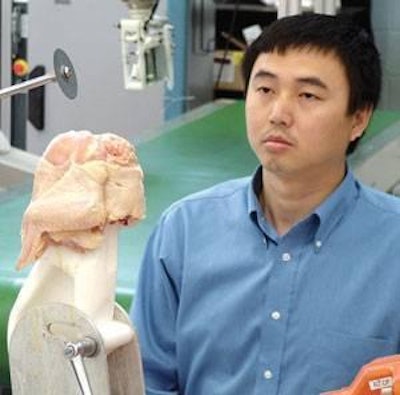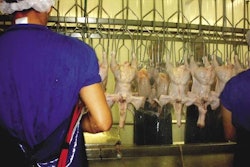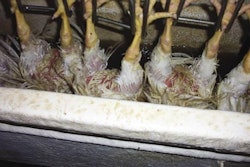
In an effort to address the poultry industry's challenge to automate the de-boning process, researchers from Georgia Tech Research Institute in Atlanta, USA, are developing a smart' de-boning system. It uses computer vision and other sensing technologies to recognise and react to size and shape differences of a chicken carcass in order to perform precision cuts that optimise yield and the amount of meat removed from the bone, while reducing the risk of bone fragments in the finished product.
De-boned chicken, especially breast meat which is the highest valued portion of the carcass in many markets, is one of the fastest growing segments of the poultry industry. This increased demand is driving the need for automation as processors seek to increase product safety and quality and reduce the labour demands of current manual processing operations.
"Currently, no cutting systems are available with the capability to adapt to changes in bird size and body deformation," explained Gary McMurray, senior research engineer and project director. "By studying the anatomical structure of the chicken shoulder, we were able to identify the cutting locations and develop a prototype intelligent or smart' device."
Combining vision, cone line and cutting
The smart de-boner comprises a vision system, a cone line and a cutting system. The vision system identifies the correct starting position for the cut and based on the size of the bird, a nominal cutting trajectory. A standard cone line moves the bird through the work cell. The cutting system employs a 3-degree-of-freedom device that is capable of adapting to the internal bird anatomy while compensating for any body deformations. Thus, as the knife moves along the cutting path for each bird, the computer automatically adjusts the path in response to the particular geometry of the bird using force feedback to perform a near optimal cut.
"The concept is to use the flexibility of the robot to allow the system to automatically compensate for the natural size variations of the bird and thus eliminate the need for any sorting based on weight," explained Dr McMurray. The elimination of weighing and sorting systems for process control could also have a big impact on the industry as far as cost savings and minimising floor space.
Researchers are currently completing a prototype for testing and evaluation of the cutting concept. According to Dr McMurray, the project team has conducted extensive testing and modelling to support the development of the prototype system. A thorough kinematic analysis of various cutting paths for the shoulder cut has been performed in order to select the best cutting motion for the automation. Mathematical models are being developed to study the cutting process and understand the impact of the material properties, sharpness of the blade, cutting velocity, and angle of the cut on the cutting force.
Theory into practice
Researchers are now completing initial tests on a first-generation prototype system and are looking forward to performing cutting experiments soon. These tests will allow researchers to verify their mathematical models as well as demonstrate the viability of the concept. Then in the winter of 2008, the team will begin testing its complete model-based control algorithms.
Although the smart de-boner has been designed with chicken in mind, Dr McMurray says that it can easily be used to perform de-boning operations in other meat products, such as beef, fish, pork and turkey, all of which have inherently similar natural variability to chicken products.
Ultimately, researchers anticipate that the concept could be used on new machines or retro-fitted to existing machines, adding more capability to adapt to product variability and thereby improving yield.
"As the industry moves to higher throughputs and increased focus on product quality, the need to automate cutting tasks increases. Our work is unique in the world as it is analytically based and it seeks to leverage off emerging analytical tools. The potential impact of this work on all the meat industries is huge. Not only will this help to move away from labour-intensive and challenging cutting tasks, but it will also help to improve yield and product quality," added Dr McMurray.
Georgia Tech Research Institute
This article is based on one published in PoultryTech, which is published by the Agricultural Technology Research Program (ATRP), Food Processing Technology Division of the Georgia Tech Research Institute (GTRI). ATRP is conducted in co-operation with the Georgia Poultry Federation with funding from the Georgia Legislature, USA.





.jpg?auto=format%2Ccompress&fit=crop&h=167&q=70&w=250)











